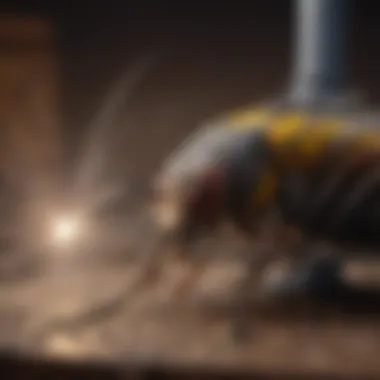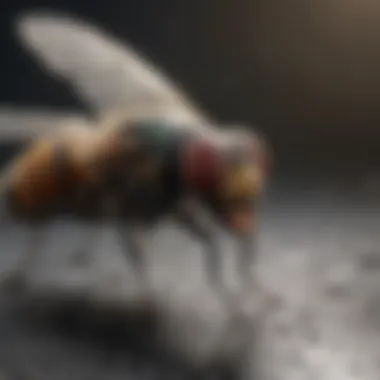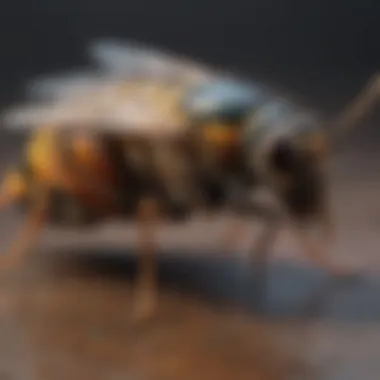Evaluating Bug Zappers for Effective Fly Control


Intro
Insect pests, especially flies, pose significant challenges in both residential and commercial settings. These creatures not only multiply quickly but can also become carriers of diseases. Tackling such infestations requires a thorough understanding of their biology and behaviors. Bug zappers, often seen as a go-to solution for flying insects, particularly raise questions about their effectiveness against flies. This article aims to dissect the nuances of their functionality, clarify misconceptions surrounding them, and juxtapose their capabilities with alternative pest control methods.
Pest Identification
Detailed descriptions of common pests
When discussing flies, it is critical to identify the types most commonly troubling households. The housefly, for instance, is prevalent in urban areas. Recognizable by its grayish body and short, bristly hairs, the housefly is notorious for its rapid reproduction and nuisance qualities. Another common pest is the fruit fly, which is much smaller and attracted to overripe fruits. It can easily invade kitchens and food storage areas.
Signs and symptoms of infestations
Identifying infestations at an early stage can prevent larger issues. Signs you may be dealing with houseflies include:
- Hearing constant buzzing sounds.
- Presence of droppings, often similar to small black specks.
- Observing them near food sources or decaying matter.
Fruit flies might surface as:
- Small, hovering insects around ripe or rotten produce.
- A noticeable increase in trash bin activity.
Recognizing these signs is crucial for effective intervention.
Prevention Strategies
Home maintenance tips for pest prevention
To diminish the likelihood of fly infestations, adhering to basic home maintenance is vital. Regular cleaning is the first step. Ensure food is stored in sealed containers. Dispose of wastes properly and routinely clean surfaces where food is prepared. Additionally, closing any gaps or openings in windows and doors helps restrict fly entry.
Natural deterrents and barriers
There are natural methods that can serve to deter flies effectively. For example:
- Essential oils: Oils such as peppermint and eucalyptus can be used as natural repellents.
- Herbs and plants: Keeping basil or lavender plants near windows can act as a barrier against flies.
Using these strategies can help maintain a fly-free environment.
Treatment Options
Overview of chemical vs. natural treatments
When faced with an infestation, understanding treatment options is imperative. Chemical treatments, such as insect sprays, provide rapid but sometimes temporary solutions. In contrast, natural remedies tend to be safer for households with pets and children, though they may require more sustained application.
Step-by-step guides for DIY treatments
- Create a vinegar trap: Mix equal parts of vinegar and water in a bowl, adding a few drops of dish soap. The scent attracts flies, and the soap traps them.
- Essential oil spray: Combine water with a few drops of essential oils. Spray around areas prone to fly activity.
- Maintain cleanliness: Regularly clean areas where flies are likely to breed, such as trash bins or food storage areas.
Proper identification and prevention strategies are key to reducing the likelihood of infestations. Understanding your treatment options, whether chemical or natural, enhances your ability to maintain a comfortable living space.
Understanding Fly Behavior and Biology
Understanding the behavior and biology of flies provides essential context for evaluating the effectiveness of bug zappers. Flies are not merely irritating pests; they play specific roles in ecosystems and have intricate life cycles that define their population dynamics. By grasping these elements, homeowners can make informed decisions about their pest control methods, especially when considering the limitations and advantages of using bug zappers.
Types of Flies Commonly Found in Homes
In any household, it is common to encounter various types of flies. Some of the most prevalent are:
- House Flies: These insects are ubiquitous and are known to feed on human food and waste. Their capacity to breed quickly contributes to rapid population growth.
- Fruit Flies: Typically attracted to decaying fruits and vegetables, fruit flies can thrive in kitchens where food is stored improperly.
- Drain Flies: Often found near sinks and drains, these flies breed in moist organic matter. They can be particularly bothersome due to their breeding habits.
- Flesh Flies: Attracted to decomposing meat, flesh flies are less common but can enter homes through open doors.


Understanding which types of flies infest homes helps in tailoring control methods. Bug zappers may not equally affect all fly species, making it crucial for residents to assess the specific fly types they encounter.
Life Cycle of Flies
The life cycle of flies includes four stages: egg, larva, pupa, and adult. Each stage has distinct characteristics:
- Egg Stage: Female flies lay hundreds of eggs in suitable environments, often in decaying organic materials.
- Larva Stage: After hatching, larvae emerge and feed on the surrounding environment, growing rapidly. This stage is critical for population increase.
- Pupa Stage: Larvae then enter the pupal stage, where they begin metamorphosis. This period can last several days to weeks, depending on environmental conditions.
- Adult Stage: Finally, they emerge as adults ready to reproduce. The entire lifecycle can take a week or two under optimal conditions.
Recognizing the life cycle helps in understanding the timescale needed for fly population control. Treatment methods, including bug zappers, can be more effective if applied at specific life cycle stages.
Attraction Factors for Flies
Flies are attracted to specific stimuli that significantly influence their behavior. Several factors include:
- Food Sources: Decaying organic matter attracts many flies. Proper food storage can mitigate their presence.
- Odors: Sweet and fermenting smells can lure fruit flies, while decomposing meat draws flesh flies.
- Moisture: Flies seek out damp areas, so controlling humidity indoors can help reduce infestations.
- Light: Many flying insects, including flies, are drawn to light. Bug zappers exploit this behavior to attract and eliminate flies.
A systematic approach to manage these attraction factors can enhance the efficiency of bug zappers and other management strategies.
By understanding fly behavior, homeowners empower themselves to choose better pest control methods, aligning them with their specific needs.
Mechanics of Bug Zappers
The mechanics of bug zappers play a crucial role in understanding their effectiveness at killing flies. These devices function primarily through electrical and ultraviolet light mechanisms that lure and eliminate various flying insects, including flies. Grasping how bug zappers operate and the different types available helps consumers make informed choices about pest control methods. This section unpacks the functional aspects and variations among bug zappers, examining their benefits and limitations.
How Bug Zappers Operate
Bug zappers attract insects using light, typically emitted by ultraviolet (UV) bulbs. Flies and other bugs are drawn to these UV lights, mistaking them for natural light sources. Once close enough, they encounter an electrified grid that delivers a fatal shock. This simple yet effective mechanism can dramatically reduce the local insect population.
One essential factor is placement. Bug zappers should be strategically placed in areas where fly activity is high. This positioning enhances their operation, allowing them to maximize efficiency at trapping insects. Moreover, the use of different light spectrums can also affect their effectiveness, with some wavelengths being more attractive to flies than others.
Types of Bug Zappers
Electric Zappers
Electric zappers are perhaps the most traditional and widely recognized form of bug zapper. They utilize an electric grid to kill flies directly upon contact. The key characteristic of electric zappers is their immediate effect on any insect that contacts the electrified surface. This instant action contributes positively to their perception as an effective fly control method.
A notable advantage of electric zappers is their ability to attract flies from a distance with their strong UV light. However, they also have disadvantages. Electric zappers can be less effective indoors, where the reflective surfaces might interfere with light visibility. Furthermore, they tend to attract a variety of non-target insects, creating an imbalance that can harm beneficial insect populations in the area.
UV Light Zappers
UV light zappers primarily rely on the lure of ultraviolet light to attract insects, without the use of an electrified grid. These zappers typically employ a fan to draw the insects into a trap where they dehydrate or get trapped.
The key characteristic of UV light zappers is their gentler approach towards pest control. They can target flies more effectively in a confined space, as they do not rely on direct shock to eliminate insects. This method is often regarded as safer, particularly in family settings, as there is no immediate electrical hazard.
One unique feature of UV light zappers is their ability to operate quietly, making them a popular choice for indoor use. However, they can also have limitations; for instance, they may require more maintenance than electric zappers due to the buildup of dead insects inside the trapping components.
Consideration: Before purchasing a bug zapper, it is essential to assess its suitability for the intended environment, whether indoor or outdoor, to ensure maximum effectiveness against flies.
Comparative Efficacy of Bug Zappers
The efficacy of bug zappers is a crucial point of discussion when considering pest control options. Their popularity arises from the common belief that they offer a simple solution to dealing with flying insects, particularly flies. However, to fully appreciate their effectiveness, it is necessary to analyze specific elements like how well they target flies compared to other pest control measures. A comprehensive understanding helps homeowners make informed decisions on which method may work best for their needs.
Effectiveness Against Flies
Bug zappers primarily attract insects using ultraviolet light. While it is widely believed they are effective in killing flies, studies present varied results. Research shows that bug zappers tend to capture a significant number of non-target insects more than actual flies. The mechanisms of attraction often draw moths and other night-flying insects more effectively than common household flies.
In many cases, homeowners using bug zappers witness limited impacts on fly populations. The key factor is that the zapper may not be effectively positioned or the surrounding environment may not support its intended functionality. It’s important to consider that flies are often attracted to other factors, such as food sources and waste, which bug zappers alone cannot address. Data suggests that bug zappers can, at times, capture a mere fraction of the fly population present in a given area.


Comparison with Other Control Methods
In addition to evaluating the effectiveness of bug zappers, it is necessary to compare them with alternative pest control methods.
Chemical Insecticides
Chemical insecticides are widely used in pest control due to their potency. One significant characteristic of chemical insecticides is their ability to swiftly eliminate insect populations. Unlike bug zappers, which primarily rely on attraction mechanisms, insecticides can target specific areas where flies are most problematic. This can be particularly beneficial in environments like kitchens where food is present.
The unique feature of chemical insecticides lies in their versatility. They can be employed in various formulations, like sprays or baits, that are directly applied to fly hotspots. However, it's vital to note that while chemical options are effective, their extensive use raises concerns about safety and environmental impact. Homeowners should be aware of the potential for harmful effects on non-target species and the toxicological risks if mishandled.
Natural Repellents
On the other hand, natural repellents offer a different approach to fly control. These methods use plant-based substances to deter flies rather than kill them. A notable characteristic of natural repellents is their relative safety compared to chemical options. They are often preferred in households with pets or children, where chemical exposure can be detrimental.
One unique feature of natural repellents is their ability to provide a more sustainable method of pest control. They tend to protect against flies without negatively impacting the ecosystem. However, their effectiveness can vary greatly depending on the ingredients used and the concentration. Homeowners may find that while natural repellents can reduce the presence of flies, they may not eliminate populations as promptly as chemical insecticides.
Critiques and Limitations of Bug Zappers
The use of bug zappers is widespread in pest control discussions. However, their effectiveness is not without critique. Understanding these critiques is vital for homeowners seeking effective solutions for fly problems. Reasons for concern include the impact on non-target insects, ecological consequences, and performance in different environments, particularly outdoors.
Non-Target Insects and Ecological Impact
Bug zappers primarily target flying insects, but they do not discriminate. Many non-target species, including beneficial insects, may be killed as collateral damage. These beneficial insects often play crucial roles in our ecosystem, such as pollination and natural pest control. According to research, bug zappers may significantly reduce populations of these helpful species, leading to unintended ecological consequences.
Some studies indicate that the total number of insects captured can surpass targeted pests like flies. Insects like moths, bees, and beetles can fall prey to the zappers. This decline can disrupt local ecosystems significantly.
"The ecological impact of bug zappers is substantial, affecting beneficial insects more than intended pests."
Homeowners should consider these effects before relying solely on bug zappers as a fly control method. Maintaining a balanced ecosystem is important for long-term pest management.
Effectiveness in Outdoor Environments
The performance of bug zappers in outdoor settings is another area of concern. Although these devices are often marketed for outdoor use, their effectiveness can vary. Factors such as wind, light pollution, and competing light sources can reduce their efficiency. Studies show that bug zappers might not catch as many flies when used in open spaces compared to enclosed areas.
Additionally, outdoor environments attract a wider range of insects. As a result, flies may not be as easily lured and captured. They may also find other food sources or resting places outside the zapper’s effective range. This shortcoming raises questions about the practicality of bug zappers for outdoor fly control.
Misconceptions About Bug Zappers
Bug zappers have garnered a variety of perceptions and beliefs among users, especially among homeowners seeking effective pest control. Understanding these misconceptions is crucial in assessing their true value, particularly in killing flies. Misconceptions can lead to misguided expectations and ineffective usage. Thus, addressing these myths can help users make better-informed decisions regarding pest management.
Common Myths
Several myths persist about bug zappers. Here are some of the most prevalent ones:
- All Insects Are Targeted: Many believe bug zappers are efficient in killing a wide range of flying insects. While it is true that zappers attract various insects, they are often less effective against flies compared to other pests like mosquitoes. This myth may lead homeowners to invest in bug zappers expecting comprehensive results.
- Immediate Results: There is a common belief that setting up a bug zapper will instantaneously eliminate a fly problem. However, the effectiveness of zappers often depends on factors like location and the level of existing infestation. Homeowners can be disappointed if they assume immediate eradication.
- Safe to Use Indoors: Some people think bug zappers are beneficial for indoor settings. Despite being marketed for indoor use, they do not effectively target flies and often harm non-target insects.
- Chemical-Free Pest Control: While bug zappers do not apply chemicals, the reality is they can inadvertently harm beneficial insects, disrupting local ecosystems. This holds importance for those prioritizing eco-friendly solutions.
What Science Says
Research offers significant insights into the actual performance of bug zappers against flies compared to what is commonly believed. Scientific studies reveal:
- Attractiveness: Bug zappers primarily attract insects that are drawn to ultraviolet light, often leaving flies unimpressed. Studies have shown that common houseflies (Musca domestica) tend to be less attracted to zappers than other insects, reflecting the limited effectiveness of these devices.
- Capture Rates: Several studies demonstrate that capture rates of flies are relatively low when compared to other control methods. Chemical insecticides tend to perform more effectively against flies, leading to more effective pest management for homeowners.
"Bug zappers may catch a few flies, but the majority of flies still remain a challenge for zappers."
- Behavioral Adaptation: Research indicates that flies may adapt to certain environmental factors, including light sources. This means that bug zappers can lose effectiveness over time as flies adjust their behaviors in response to the presence of these devices.
In summary, misconceptions about bug zappers can mislead homeowners. By understanding common myths and filtering them through scientific evidence, consumers can cultivate realistic expectations. This knowledge enables better decisions regarding pest control methods, allowing them to choose solutions that truly tackle their fly problem.


Best Practices for Using Bug Zappers
Having a bug zapper in your home can be an effective way to reduce fly populations. However, to get the most benefit from your zapper, understanding best practices is essential. These practices guide placements and maintenance. Both are crucial for maximizing effectiveness while minimizing potential drawbacks.
Placement Strategies
Placement of bug zappers reflects a critical operational consideration. Correct positioning can greatly influence how well they function against flies.
- Proximity to Attraction Sources: Set your bug zapper near areas where flies gather. These could be trash bins, compost heaps, or even areas with outdoor cooking. By placing zappers close to these hotspots, you increase the chance of attracting flies.
- Elevation Matters: Positioning the zapper at an elevated level can be beneficial. Flies tend to fly lower, so a height of around four to six feet may be ideal. It also helps in maximizing exposure to potential flies in flight.
- Minimize Light Distraction: Avoid placing zappers near intense lights. Bright lights from homes can divert flies’ attraction away from zappers. This ensures flies remain focused on the zapper, raising their likelihood of being caught.
- Environmental Considerations: In outdoor settings, placing the zapper in shaded areas can enhance its effectiveness. When zappers are in direct sunlight, they may overheat and cause their efficiency to drop.
Maintenance and Cleaning
Regular maintenance keeps bug zappers functioning at peak performance. Keeping them clean eliminates blocked surfaces and ensures they attract insects effectively.
- Regular Cleaning: It is vital to clean the electric grids frequently. Debris and dead insects can accumulate, causing the zapper to work less efficiently. A cleaning schedule every few weeks is reasonable.
- Power Sources: Make sure to routinely check its power sources. If the zapper is plugged into an outlet, look for any wear or damage. For battery-operated models, ensure to replace the batteries regularly for consistent performance.
- Safe Handling: When cleaning, always unplug the device. This provides safety. Use a soft brush to gently remove debris without damaging the grid.
- Check for Damage: Citizens should regularly inspect their bug zappers for any signs of wear or malfunctioning parts. Addressing issues promptly can prevent larger problems down the line.
"Regular maintenance and strategic placement of bug zappers can significantly enhance their effectiveness in controlling fly populations."
Staying diligent about these best practices helps homeowners see better results in managing the fly populations in and around their homes.
Statistical Insights
Understanding the statistical insights related to bug zappers is crucial for evaluating their true effectiveness in killing flies. Statistics can illuminate patterns and outcomes that anecdotal evidence often overlooks. They help homeowners make informed decisions regarding pest control methods. In addition, statistical data can highlight how bug zappers compare with other options available in the market. Here, we will examine findings from studies and user surveys that shed light on the performance of bug zappers.
Effectiveness Rates Documented in Studies
Numerous studies have assessed how well bug zappers kill flies, revealing a varied effectiveness rate.
- One study published in the Journal of Economic Entomology found that bug zappers killed a substantial number of house flies. However, their efficiency dropped when other factors, like baiting and environmental conditions, were introduced.
- Another research highlighted that bug zappers primarily attract other insects, with varying results on their effectiveness against house flies specifically.
"While bug zappers kill some flies, they might not be the universal solution many homeowners expect." This suggests a more nuanced application rather than relying solely on bug zappers.
Moreover, tests conducted in different environments have shown inconsistent results. Factors such as placement and configuration of bug zappers play a role in their success, which emphasizes the importance of contextual analysis when interpreting study results.
User Reports and Surveys
User testimonials and surveys provide a different perspective on bug zappers' effectiveness. Many homeowners report that bug zappers offer a convenient solution for reducing fly populations. Survey analyses reveal that:
- Approximately 70% of users stated they noticed a reduction in flies after installing bug zappers in their yards or homes.
- About 50% of users mentioned that they supplemented bug zappers with other control methods, indicating it is often perceived as part of a larger strategy rather than a standalone solution.
Feedback from forums like Reddit often includes pros and cons. On the positive side, users applaud the low-maintenance aspect of bug zappers. However, some express disappointment when the devices fail to eliminate flies effectively, particularly in high-infestation areas. This highlights the critical need for potential users to approach bug zappers with realistic expectations.
End and Recommendations
In concluding the exploration of bug zappers, it becomes evident that their utility in managing fly populations deserves careful consideration. The clear benefits that emerge from this discussion include understanding how these devices operate, their specific effectiveness levels, and the various factors influencing their success in practice. This informed perspective will help homeowners make the best decisions regarding pest control solutions in domestic spaces.
The evidence supports that, while bug zappers can reduce some fly populations, they do not address the broader concerns of pest management. Homeowners must appreciate these limitations and not rely solely on zappers. This is particularly important in environments where flies breed and multiply rapidly.
Importantly, the efficacy of bug zappers varies significantly based on factors such as placement, type of zapper, and local fly populations. In practical terms, households should consider these variables to enhance the effectiveness of their pest control strategies. Moreover, integrating bug zappers with other control methods could be more fruitful than relying on any single solution.
Summary of Findings
- Bug zappers are somewhat effective against adult flies, but their reach does not typically cover entire areas.
- Studies show mixed results regarding the capture rates of zappers, often illustrating their ineffectiveness against specific species.
- Complementing bug zappers with natural repellents or cleanliness can yield better outcomes in managing household flies.
"Understanding the broader context of pest control can lead to more successful strategies for fly management."
Practical Advice for Homeowners
For homeowners looking to implement bug zappers effectively, consider these recommendations:
- Placement: Position zappers in areas where fly activity is highest. For instance, around garbage areas or near entry points can be beneficial.
- Types of Zappers: Select zappers based on the specific type of fly prevalent in your area. Electric zappers may work differently than UV light models.
- Combining Methods: Use bug zappers in tandem with other methods, such as traps or natural deterrents, for a more holistic approach.
- Maintenance: Regularly clean and maintain the zappers to ensure optimal performance. Built-up debris can hinder their effectiveness.
- Monitoring: Keep track of fly populations to assess whether the zappers are making a measurable difference in your control efforts.
By following these practical tips and realizing the limitations of bug zappers, homeowners can formulate a more effective pest management strategy.



